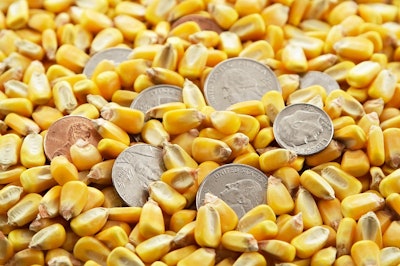
The world may be arriving at the beginning of the end of the COVID-19 pandemic.
In an appearance at the National Chicken Council’s (NCC) Annual Meeting in Washington, Dr. Paul Aho, an economist with Poultry Perspective, examined recent events relevant to the grain and poultry markets and offered his predictions for the coming year. He spoke on October 28, 2021.
The long shadow of COVID
The global COVID-19 crisis continues in 2022. Since the disease appeared in 2020, it’s continued to play a role in economic uncertainty and logistical upheaval. Aho said current vaccination figures indicate the world could be nearing the end of the pandemic which colored life for so long.

Abruptly halting and then throwing the global economy back to full speed created problems in global trade. The combination of workforce and supply chain disruptions with rapidly increasing demand exposed a shortage of shipping containers, trucks and drivers.
Moreover, the disease caused some to exit the workforce or re-assess the necessity of working given their health and family situation. Aho predicts once the COVID-19 crisis ends – or when it is no longer causing problems with daily life, child care and public health – then more workers will be available. Employers may need to pay higher wages to attract them, however.
Chilling winter
2022, Aho said, will begin with the most populous part of the world heading into its coldest months while paying high prices for all kinds of energy. For example, he said, liquid natural gas spot prices in Asia rose sevenfold compared with the prior year and the product is in short supply across Europe and Asia.

Corn prices
Poultry producers paid higher than normal grain prices in recent months, but that could be ending soon. Aho said he believes global grain production will increase causing prices to normalize and then fall.
Like all markets, corn experiences bear and bull trends. In the short term, corn prices rose dramatically in 2021 and have been rising steadily since 2005. In the long term, Aho said, corn is on a 150-year-long bear run.
If adjusted for 2019 dollars, the price of corn is lower now than it was in 1860 due to gains in efficiency during that period and relatively few major interruptions which temporarily increased prices. The steady fall in prices, he said, aided in the development and success of the domestic poultry industry.
For 2022, Aho expects corn will enter a bear market. The U.S. Department of Agriculture forecasts the price of corn for the current crop year will be $5.45 a bushel. He expects about $5, which is higher than last year, but he thinks that average price should be the top of the market.
Chicken trends
Globally, the grain bull market and world COVID recession lowered the demand for meat – particularly beef and pork – and discouraged increased poultry production around the world.
In 2019, the global production of chicken increased significantly as China attempted to fill the protein deficit created by African swine fever (ASF) in that country. In 2020, world chicken production grew slightly. In 2021, it was flat.
Aho expects year-over-year global chicken production will grow by less than 2% in 2022. That should be the normal growth rate going forward based on current population and consumption trends.
By 2030, he expects global, per capita pork and chicken consumption will be near equal. During the same period, he expects consumption of farm-raised seafood, eggs and alternative proteins to rise while consumption of beef will fall. Beef is suffering due to its high price compared with other meats.
The U.S. produces more chicken than its population can eat, so export markets are key for continued industry growth. COVID was not good for international chicken trade, Aho said. Global chicken trade rose in 2019, as consequence of the ASF outbreak in China, but slowed in 2020 and 2021 due to COVID. He expects demand will grow again in 2022.
Parts prices followed the same V-shaped model as the broader economy, falling during 2020 and rising right back in 2021. Wing prices continue to be abnormally high as consumers cannot get their fill of the part.
Poultry meat trade quantity increasingly dominates www.WATTAgNet.com/articles/44020

















